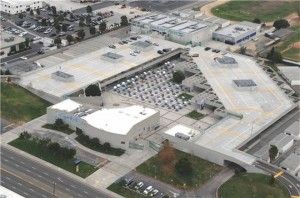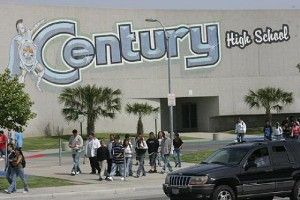More Taxes for Skoolz?
FEB. 7, 2012
By JOHN SEILER
I’m enjoying the tiff between Gov. Jerry Brown and the other tax-increase forces in the state, in particular activist lawyer Molly Munger and the California Teachers Association. As Dan Walters notes today, Brown’s $7 billion tax hike still wouldn’t prevent cuts to K-12 schools. Munger’s $10 billion would prevent the cuts.
Munger’s initiative would increase income taxes on everyone. That is, everyone who pays income taxes in the first place. About half of Californians don’t.
California already suffers the most regressive income tax in the country. The 9.3 percent current “top” rate digs in at about $55,000 of income. (Technically, there’s also a 1 percentage point additional insane tax on million-dollar incomes to fund state mental health programs.)
Munger’s tax increase would jump that middle-class tax rate up an average of 1 percentage point, for a total tax of 10.3 percent. I hope she qualifies the ballot measure and spends her entire fortune on promoting it. (Molly: Spend all your money on this. Do it for the children.)
There’s no way her tax will pass. And Brown’s tax increase will fail, too, as will the CTA’s tax increase.
Let’s put them all on the ballot. The teachers unions also should spend all their coffers trying to pass these tax increases. Indeed, they should borrow $100 million more to pass them. (Unions: Spend all your money on this. Do it for the children.)
People are starting to wake up to how crummy California’s schools really are. And pouring more money on them won’t improve anything.
 Factory Schools
Factory Schools
Some people even are realizing that the whole public school paradigm, of warehousing kids in buildings that resemble factories or even prisons, is something from the machine age of a century ago. You put raw materials (steel, plastic, children) into one end of the factory, and out of the other end off the assembly line rolls a “product” (a car, or a high-school graduate sufficiently indoctrinated).
Look at the picture at the top. It’s of Century High School in Santa Ana. And check out the aerial view at the right. It sure looks like a factory — or a prison. It’s sealed off from the surrounding neighborhood. The entrances and exits are closely controlled. It serves institutional food.
But this is the Internet Age, where everything is being dispersed into decentralized networks. As you read this, do you know where the data for CalWatchDog.com is comes from before it gets to your computer or smart phone or iPad? I sure don’t, even though I’m the managing editor. It could be in California, or another state, or another country, or all of them. The Internet is decentralized. “Packets” of information are shifted around depending on protocols that only the top nerds understand.
Now, consider the name of Munger’s tax-increase movement: “Our Children, Our Future.”
“Our” children? It’s like we’re in some 1930s Soviet collective, where everyone is making the same bolt for the same state-run factory.
No, they’re not “our” children, Molly. Children belong to their parents until the kids turn 18.
And by saying they’re “our” children, she’s still imposing the 1930s-style, top-down, factor/prison model of schooling.
What we need are decentralized, dispersed, networked schools — beginning with the ultimate decentralization, home schools.
Even the liberal Newsweek/Daily Beast magazine has figured this out. It writes, “When Tera and Eric Schreiber’s oldest child was about to start kindergarten, the couple toured the high-achieving public elementary school a block away from their home in an affluent Seattle neighborhood near the University of Washington. It was ‘a great neighborhood school,’ Tera says. They also applied to a private school, and Daisy was accepted. But in the end they chose a third path: no school at all.”
Yes! The best school is no school.
Doing Better
The article continues: “We think of homeschoolers as evangelicals or off-the-gridders who spend a lot of time at kitchen tables in the countryside. And it’s true that most homeschooling parents do so for moral or religious reasons. But education observers believe that is changing. You only have to go to a downtown Starbucks or art museum in the middle of a weekday to see that a once-unconventional choice ‘has become newly fashionable,’ says Mitchell Stevens, a Stanford professor who wrote Kingdom of Children, a history of homeschooling. There are an estimated 300,000 homeschooled children in America’s cities, many of them children of secular, highly educated professionals who always figured they’d send their kids to school—until they came to think, Hey, maybe we could do better.
“When Laurie Block Spigel, a homeschooling consultant, pulled her kids out of school in New York in the mid-1990s, ‘I had some of my closest friends and relatives telling me I was ruining my children’s lives.’ Now, she says, ‘the parents that I meet aren’t afraid to talk about it. They’re doing this proudly.’
“Many of these parents feel that city schools—or any schools—don’t provide the kind of education they want for their kids. Just as much, though, their choice to homeschool is a more extreme example of a larger modern parenting ethos: that children are individuals, each deserving a uniquely curated upbringing. That peer influence can be noxious. (Bullying is no longer seen as a harmless rite of passage.) That DIY—be it gardening, knitting, or raising chickens—is something educated urbanites should embrace. That we might create a sense of security in our kids by practicing ‘attachment parenting,’ an increasingly popular approach that involves round-the-clock physical contact with children and immediate responses to all their cues.
“Even many attachment adherents, though, may have trouble envisioning spending almost all their time with their kids—for 18 years! For Tera Schreiber, it was a natural transition. When you have kept your kids so close, literally—she breast-fed her youngest till Violet was 4—it can be a shock to send them away.
“Tera’s kids didn’t particularly enjoy day care or preschool. The Schreibers wanted a ‘gentler system’ for Daisy; she was a perfectionist who they thought might worry too much about measuring up. They knew homeschooling families in their neighborhood and envied their easygoing pace and flexibility—late bedtimes, vacations when everyone else is at school or work. Above all, they wanted to preserve, for as long as possible, a certain approach to family.”
Imagine that: tailoring schooling to meet each kid’s unique needs.
Deschooling and Decentralization
Let’s return to our computer analogy. I’ll bet you $10,000 that my computer “desktop” looks different from yours. I’ve tailored my desktop to my needs. You’ve tailored your desktop to your needs. There’s no “one size fits all.”
Then why do we impose a “one size fits all” mold on students in school? Why must they conform?
More people are realizing this. When voters reject whatever tax increases make it to the November ballot, school budgets will have to be cut even more. Ultimately, the budgets should be cut to zero.
Let’s free the parents to teach their children as they see fit. Let’s free the children to learn and live.
Related Articles
Senate pushing nutty new school-finance scheme
April 29, 2013 By John Seiler The state supposedly “balanced” its budget only with the Prop. 30 tax increase. Three
Debate: Kashkari closing channels Reagan in 1980
Questioner asks about high cost of UC, CSU being barrier to poor students. Kashkari sympathizes and cites student loan burders.
Hearing: Bulk of school spending will go to construction
Aug. 8, 2012 By Katy Grimes SACRAMENTO — Lawmakers say they want to help California’s failing schools. They say they



